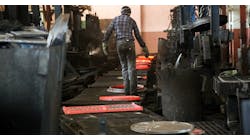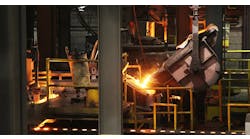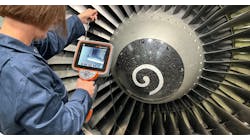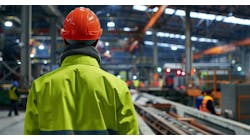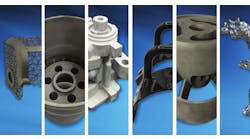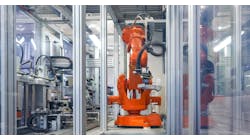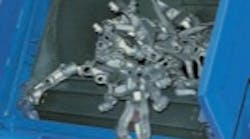Cleaning castings is integral to every foundry's operation. The type of castings including size, weight, and shape, and the production rate, are all important factors in choosing the appropriate blast cleaning equipment, but these are not the only considerations. With a variety of molding processes producing thousands of casting types and configurations, there are numerous arrangements for cooling, sand shakeout, and degating. All of these upstream operations influence the cleaning requirement. Subsequent operations, such as the final use of the casting, may also play a part in the blast arrangement selection process.
Ideally, casting temperature would be ambient entering the blast operation, but with large variations in cooling time from foundry to foundry, temperatures at the blast machine are wide ranging. Designing for the maximum temperature is essential to reducing maintenance, downtime and other problems, including safety hazards. Standard foundry-duty blast machines generally handle castings up to 100°C with few changes. At this temperature, tumblast machines require steel or manganese mill conveyors instead of rubber belt work conveyors, which may satisfy certain lower temperature requirements. Higher temperatures, up to 175°C, necessitate special high-temp seals, curtains, and elevator belts.
These higher temperatures also result in special maintenance considerations to address the safety hazards related to adjustment and repairs on hot machine components operating with hot abrasives. From ambient to 175°C, the cooling arrangement has less influence on the machine selection than on the types of components needed to withstand the heat. Much less frequently, even hotter castings are processed in blast equipment. Bearing lubrication, work conveyor design, wear material composition, ventilation and the control system often require changes for these requirements. Chains and other non combustible materials are used in place of high-temp rubber seals, curtains, and belts. Processing very hot castings also increases the potential for expanding hot air carrying silica dust outside of the blast system. Extra-high casting temperatures can have a significant influence on the type of blast machine that can be used to satisfy the cleaning requirement.
In most sand foundries, the majority of sand is removed during a shakeout operation. This aids the cooling process and minimizes the amount of sand to be removed later by the blast cleaning operation. In a low percentage of requirements, sand removal is accomplished solely by the blast machine with no previous shakeout operation. The total volume of material entering the blast machine can include more sand than metal. Commonly referred to as full mold or core knock-out operations, these blast systems are designed with special reclaim systems for handling the heavy sand surge that occurs early in the blast cycle. Separation of sand from steel blast media, usually round shot, is accomplished with magnetic separation and/or airwash separation.
When airwash separation is selected, a double deck airwash zone is used, often in conjunction with a secondary magnetic/airwash assembly. In full mold or core knock-out applications, high sand temperatures are not uncommon and must be considered in the selection of the separation system, because high temperatures can reduce the effectiveness of magnetic separation. Handling full molds at the blast operation, and providing effective blast coverage, is usually achieved by placing the mold on a table or in a spinner hanger basket. It is conveyed into the blast compartment and rotated for sand removal and cleaning.
When shakeout precedes the blast operation, it is usually a vibratory unit or rotary drum. The shakeout's effectiveness at breaking down the mold and cores directly effects the cleaning requirement at the blast machine. Rotary shakeouts, utilizing tumbling media, can significantly reduce the amount of adhered sand remaining when the castings reach the blast operation. This allows faster cleaning or cleaning with reduced blast capacity.
After analyzing how upstream operations affect the blast requirement, the next step is selecting the type of cleaning process, i.e. batch, continuous in line, or individual part cleaning. Common batch machines types include tumblasts, spinner hangers, and tables. An advantage of batch cleaning is that blast times can be adjusted for different casting configurations to provide single-cycle cleaning in most requirements. Occasionally, in table blast operations, castings will be flipped and cleaned in two cycles.
Tumblasts are the most efficient batch cleaning method, provided castings can be tumbled without damage. Automated load and unload operations significantly enhance the productivity of foundry tumblast operations. Spinner hangers are popular for cleaning safety-critical castings, as well as many other casting types that are prone to breakage if tumbled. Tables are normally used for large castings or any castings that cannot be tumbled and are not easy to chain or fixture for cleaning in a spinner hanger.
Continuous blast arrangements are used in many highproduction foundries and include continuous tumblasts, continuous rocker barrels, vibra tunnel blast machines and pass through mesh belt machines. For most continuous cleaning requirements, sizing the work conveyors and blast capacity properly is critical to minimizing reblast requirements, especially when there is a wide variation in the casting configurations. Continuous machines need to be sized to accept the heaviest possible casting surge over a short time interval, as well as the average hourly tonnage or volume of castings.
Casting density is an important consideration in the selection of both continuous and batch cleaning equipment. Several machines designed for cleaning specific casting types include gripper and manipulator arrangements for blocks and heads, inclined belt machines for brake drums and rotors, spinner roll machines for cast tubes, and walking-beam and roll conveyor machines for internal cleaning of blocks and heads with automated airblast. Pass-through monorail spinner hangers are a cross between batch and continuous handling, and are used for medium- to high-production cleaning of many types of castings.
Various blast cleaning operations are used by foundries. Most common is a primary blast following shakeout and degating. In some requirements, detached gating and sprue are cleaned along with the castings to remove sand prior to remelt. Other times, gating and sprue are diverted to a dedicated cleaning operation. After grinding, many foundries will use a finish-blast operation to blend in grinding marks and provide a consistent finish before shipping. Occasionally, a pre-blast operation is located between shakeout and manual degating for removing most sand, which limits exposure by downstream degating operators to potentially hazardous dust. After gating and sprue are removed, the castings proceed to a primary blast operation for complete cleaning.
Blast testing is available to help determine the most effective cleaning arrangement for foundry requirements. Wheelabrator Group's testing and demonstration department includes batch and continuous machines, as well as multi-purpose equipment for simulating many different blast arrangements and parameters. Confirming the cycle times for batch machines and the cleaning rate for continuous machines is an important step toward achieving a successful blast cleaning installation.
From automotive, truck, construction and farm equipment components, soil pipe fittings, to cast iron cookware, valve bodies and bonnets, and municipal castings, there is a huge variation in casting handling and cleaning requirements. Investigating all of the variables and processes that influence the blast requirement is important to determining a foundry's most effective blast-cleaning solution.
Bill Raby is the Foundry Sales Manager for Wheelabrator Group. For more information, visit www.wheelabratorgroup.com.
